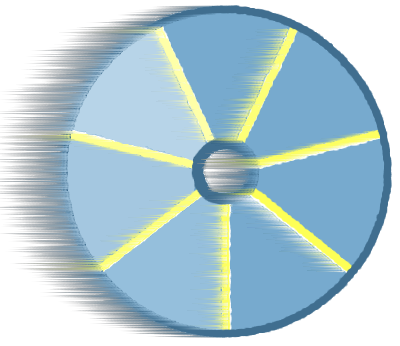Just and Sustainable Land Use Policy
Contents of these web pages

Good intentions gone awry?
Walt Disney named this Disneyland attraction “Autopia” reflecting his belief that progress was bringing us a better world.
Reversing a century of autopian planning
Santa Cruz County is making fitful progress on reversing its version of our nation’s blind embrace of automobile dependency. The Campaign for Sustainable Transportation recognizes that one bad land use decision, such as locating Kaiser offices and 730 space parking structure a mile from the nearest bus stop, can reverse years of community effort to reduce auto trips. It chains Kaiser employees to the expense of operating their cars.
We have a Sustainable Santa Cruz County Plan to channel development along transit corridors. But new development continues to seek lower cost land in transit deserts and elected officials continue to approve exceptions to the Plan.
Eliminating antiquated local requirements to spend scarce resources on parking is the most under-rated strategy to reduce vehicle trips and improve affordability in market-rate housing.

Pacific Ave. at Soquel Ave. 1904

Replacement of streetcars with buses 1924
From streetcar villages to sprawl
In the early 20th century, most trips were walking trips. Streetcars carried walkers to the beach as well as villages of Seabright and Capitola. Today’s wide streets on Woodrow, Morrissey, and Cayuga remain as the legacy of former streetcar routes. New development concentrated within walkable distance from streetcar lines.
The automobile brought about amazing freedom of mobility. But there were serious costs early on, as streets that were once safe for strolling now brought injury and death to pedestrians. As new development sprawled beyond urban boundaries, a new poverty of mobility was born. Where once rich and poor alike relied on walking, now vehicle ownership became increasingly necessary to access destinations that used to be reachable on foot and streetcar. Streetcars lines were torn out. Those who didn’t own vehicles made do riding the bus.
“A developed country is not a place where the poor have cars. It’s where the rich use public
transportation.”

Transportation and Land Use Justice
People seeking less expensive housing take on longer commutes. But sometimes the additional transportation expense outweighs the savings in housing. In Riverside, Ca. the average household spends 36% of income on housing and a whopping 33% on transportation. In San Francisco, the average household spends 33% of income on housing and 21% on transportation. The difference is that San Franciscans can access their destinations without car ownership.
To increase housing-&-transportation affordability in Santa Cruz we need to build more housing near jobs, schools, recreation and amenities. That means channeling growth to transit corridors. This growth needs to take place without the displacement of low-income households that has been documented in places with new transit-oriented development.
Getting the housing we need is a 30 year project. In the meantime, we need to support households to reduce car ownership by investing in transit and safe streets for bicycling and walking. With the political will, that could be a short-term project.
Resources
Websites
- Complete Communities Toolbox – attractive, inclusive, efficient, healthy & resilient places; University of Delaware Institute for Public Administration, https://www.completecommunitiesde.org
- Placemakers – We’re planners, urban designers, form-based code wranglers, storytellers, advisors and advocates. http://www.placemakers.com
- TransForm promotes walkable communities with excellent transportation choices to connect people of all incomes to opportunity, keep California affordable, and help solve our climate crisis. With diverse partners we engage communities in planning, run innovative programs and win policy change at the local, regional and state levels. Includes online GreenTRIP Connect tool. https://www.transformca.org
- Through research, education and advocacy, SPUR promotes good planning and good government in the San Francisco Bay Area. https://www.spur.org
- Catalyze SV is engaging community members, developers, and city leaders to envision and create sustainable, equitable, and vibrant places for people in Silicon Valley. https://www.catalyzesv.org
- The purpose of the Vision for Civic Conservation is to provide a framework of guiding principles with which to address progress and growth in local communities, primarily from within Historic Districts. http://www.civicconservation.org
Books/Reports
- Modernizing Mitigation: A Demand-Centered Approach, September 2018, State Smart Transportation Initiative, https://www.ssti.us/wp/wp-content/uploads/2018/09/Transit-Center-final-report.pdf
- Mixed-Use Development Handbook, by Dean Schwanke, Urban Land Institute, 2003, https://uli.bookstore.ipgbook.com/mixed-use-development-handbook-products-9780874208887.php
- Videos
“Complete Communities – Designing Better Places”, video series from State of Delaware, 7 short videos:
1. Prospect & Refuge;
2. Design Principles, Creating an Outdoor Room;
3. Architectural Characteristics of Buildings, Building Placement;
4. The Change from Pedestrian Scale to Auto Scale After WWII;
5. How Streets Are Built;
6. Creating a Pleasant Pedestrian Experience; and
7. Why Does This Matter? - https://www.completecommunitiesde.org/community-design-tools/videos/
“Parking reform for 21st century communities”, 1-hour webinar, https://formbasedcodes.org/articles/webinar-recap-parking-reform-21st-century-communities/ - “Poynton Regenerated”, story of how a key intersection in the town center of Poynton, Cheshire, UK was redesigned to become a shared space, https://youtu.be/-vzDDMzq7d0

